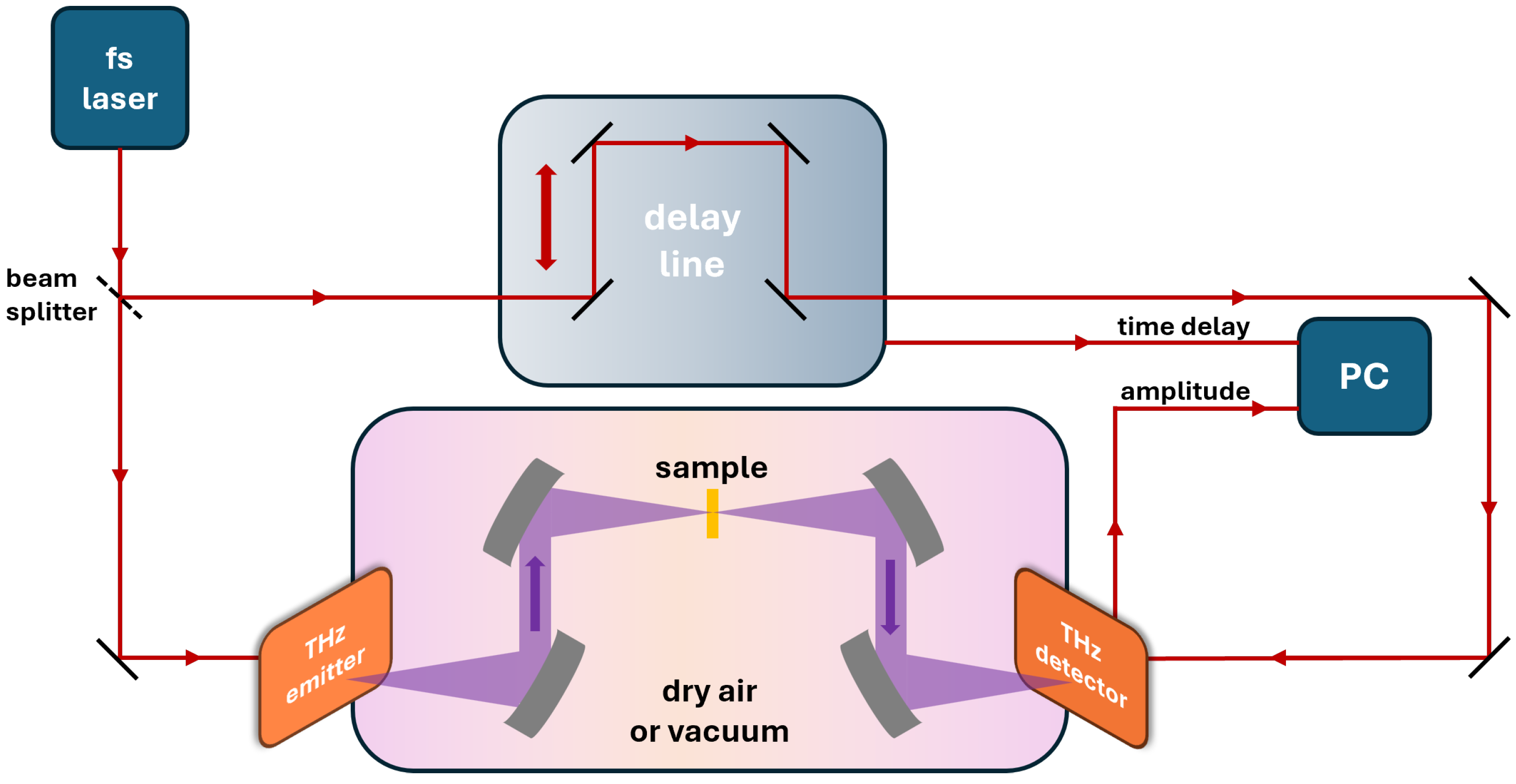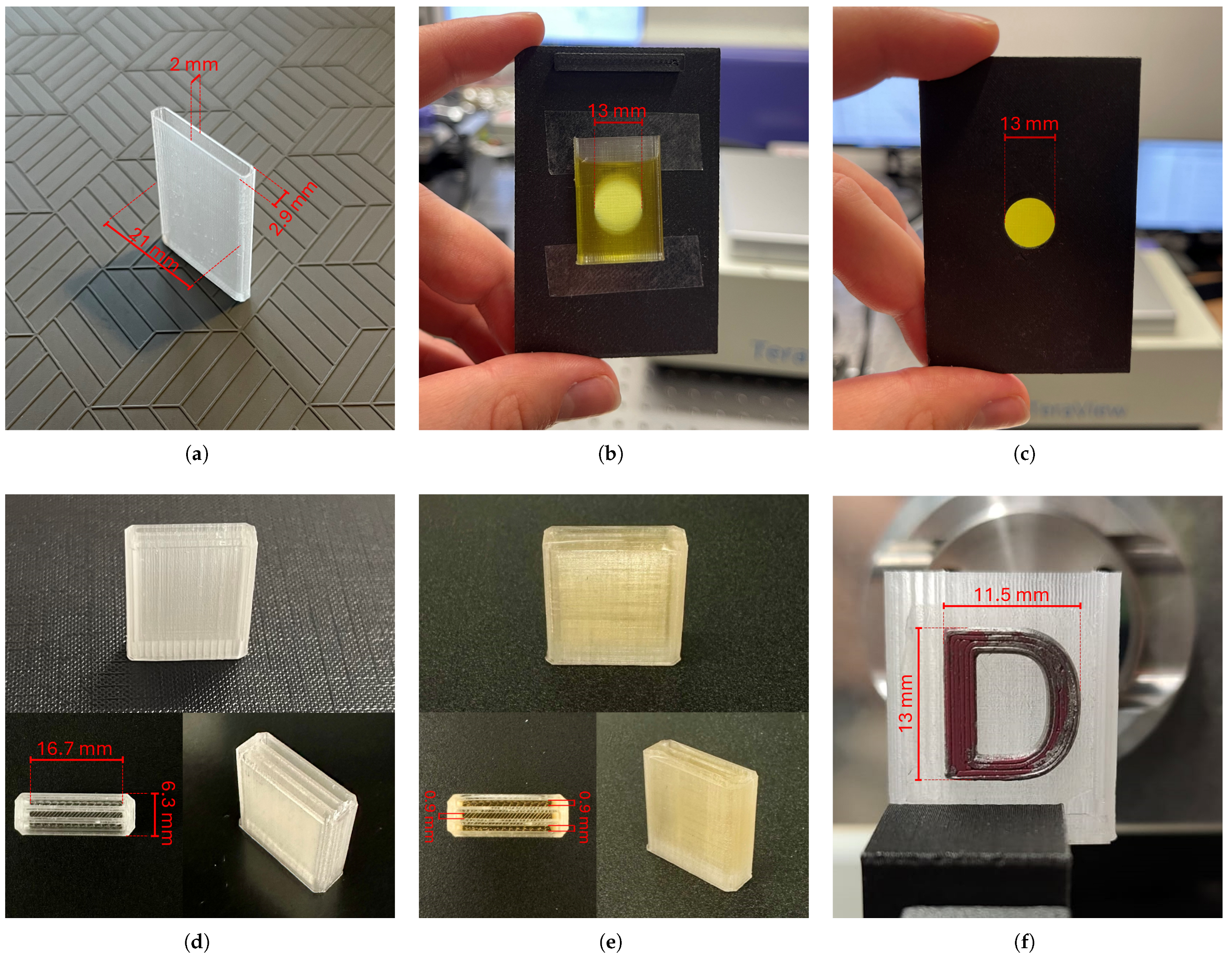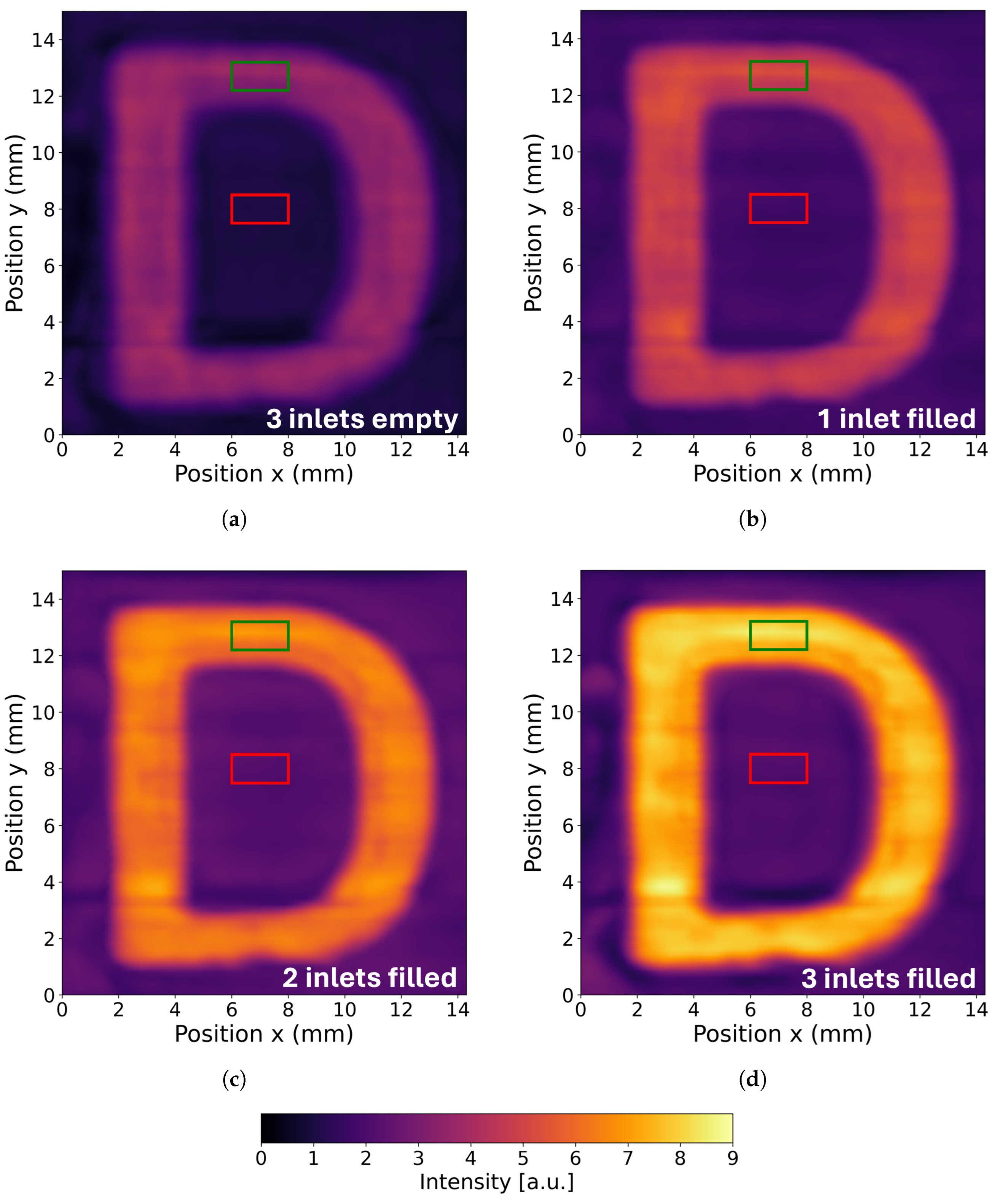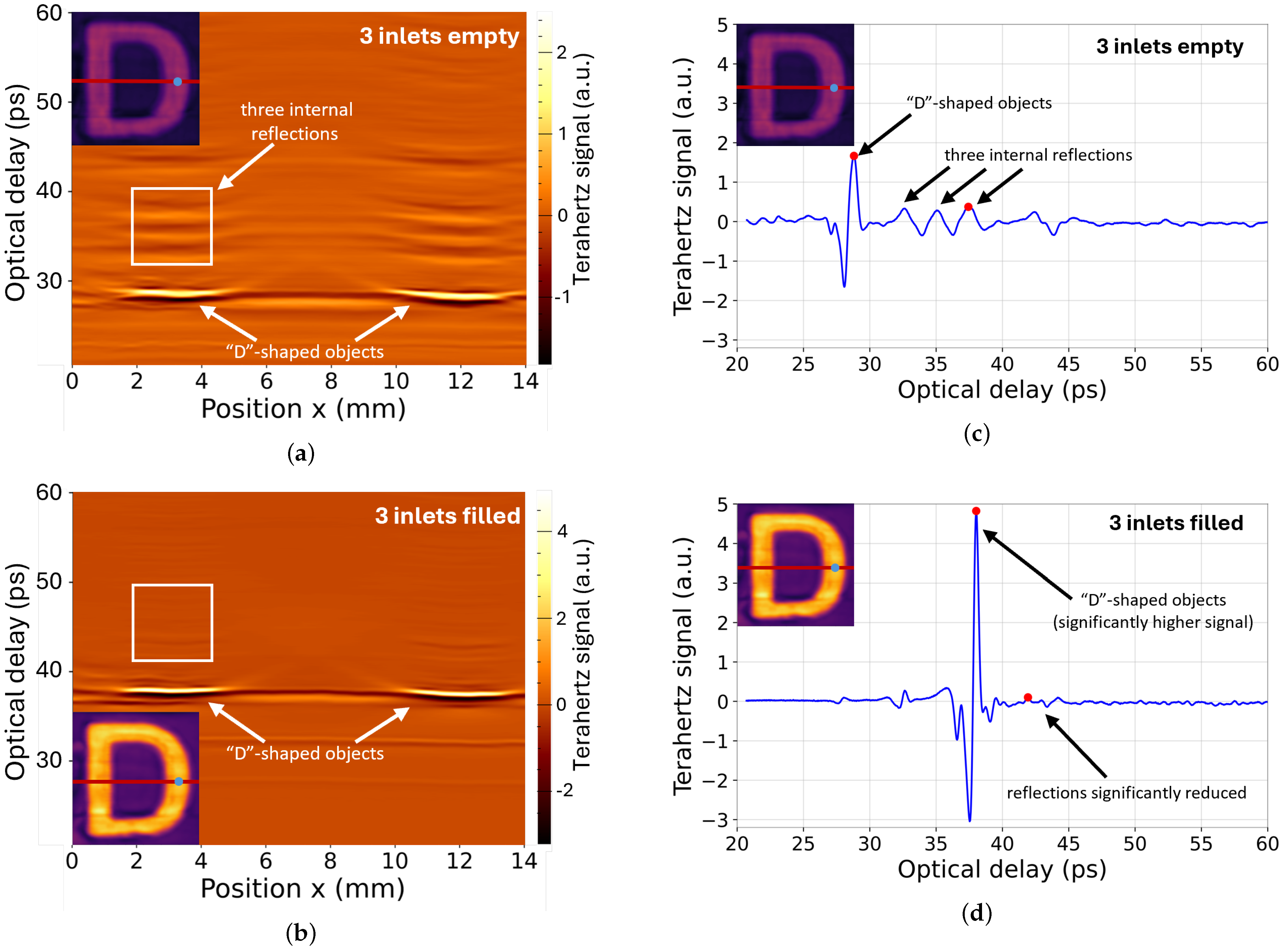Reduction in Reflection Signal Losses in Complex Terahertz Optical Elements Through Tailored Oil Application
Abstract
1. Introduction
2. Materials and Methods
2.1. Optical Properties Investigation
2.2. Multilayer Structures Design, Manufacturing and Investigation Methods
3. Experimental Results
3.1. Optical Properties Measurements
3.2. Multilayer Structures Measurements
4. Discussion
5. Conclusions
Author Contributions
Funding
Data Availability Statement
Acknowledgments
Conflicts of Interest
Abbreviations
| ABS | acrylonitrile butadiene styrene |
| COC | cyclic olefin copolymer |
| DLP | digital light processing |
| FDM | fused deposition modeling |
| HDPE | high-density polyethylene |
| HIPS | high-impact polystyrene |
| IMPATT | Impact Ionization Avalanche Transit-Time Diode |
| LLDPE | linear low-density polyethylen |
| PA12 | polyamide 12 |
| PETG | polyethylene terephthalate glycol-modified |
| PP | polypropylene |
| PTFE | polytetrafluoroethylene |
| RTD | Resonant Tunnelling Diode |
| SBC | styrene-butadiene copolymer |
| SLS | selective laser sintering |
| THz | terahertz |
| THz TDS | terahertz time-domain spectroscopy |
| TPE | thermoplastic elastomer |
| VDI | Virginia Diodes Inc. |
| VP/VA | vinylpyrrolidone/vinyl acetate copolymers |
References
- Markelz, A.G.; Mittleman, D.M. Perspective on terahertz applications in bioscience and biotechnology. ACS Photonics 2022, 9, 1117–1126. [Google Scholar] [CrossRef]
- Yan, Z.; Zhu, L.G.; Meng, K.; Huang, W.; Shi, Q. THz medical imaging: From in vitro to in vivo. Trends Biotechnol. 2022, 40, 816–830. [Google Scholar] [CrossRef] [PubMed]
- Chernomyrdin, N.V.; Musina, G.R.; Nikitin, P.V.; Dolganova, I.N.; Kucheryavenko, A.S.; Alekseeva, A.I.; Wang, Y.; Xu, D.; Shi, Q.; Tuchin, V.V.; et al. Terahertz technology in intraoperative neurodiagnostics: A review. Opto-Electron. Adv. 2023, 6, 220071. [Google Scholar] [CrossRef]
- Shafie, A.; Yang, N.; Han, C.; Jornet, J.M.; Juntti, M.; Kürner, T. Terahertz communications for 6G and beyond wireless networks: Challenges, key advancements, and opportunities. IEEE Netw. 2023, 37, 162–169. [Google Scholar] [CrossRef]
- Jiang, W.; Han, B.; Habibi, M.A.; Schotten, H.D. The road towards 6G: A comprehensive survey. IEEE Open J. Commun. Soc. 2021, 2, 334–366. [Google Scholar] [CrossRef]
- Knipper, R.; Brahm, A.; Heinz, E.; May, T.; Notni, G.; Meyer, H.G.; Tunnermann, A.; Popp, J. THz absorption in fabric and its impact on body scanning for security application. IEEE Trans. Terahertz Sci. Technol. 2015, 5, 999–1004. [Google Scholar] [CrossRef]
- Tao, Y.H.; Fitzgerald, A.J.; Wallace, V.P. Non-contact, non-destructive testing in various industrial sectors with terahertz technology. Sensors 2020, 20, 712. [Google Scholar] [CrossRef]
- Headland, D.; Monnai, Y.; Abbott, D.; Fumeaux, C.; Withayachumnankul, W. Tutorial: Terahertz beamforming, from concepts to realizations. APL Photonics 2018, 3, 051101. [Google Scholar] [CrossRef]
- Khonina, S.N.; Kazanskiy, N.L.; Skidanov, R.V.; Butt, M.A. Advancements and applications of diffractive optical elements in contemporary optics: A comprehensive overview. Adv. Mater. Technol. 2025, 10, 2401028. [Google Scholar] [CrossRef]
- He, J.; Dong, T.; Chi, B.; Zhang, Y. Metasurfaces for terahertz wavefront modulation: A review. J. Infrared Millim. Terahertz Waves 2020, 41, 607–631. [Google Scholar] [CrossRef]
- Sun, J.; Hu, F. Three-dimensional printing technologies for terahertz applications: A review. Int. J. RF Microw. Comput-Aid. Eng. 2020, 30, e21983. [Google Scholar] [CrossRef]
- Wu, G.B.; Chen, J.; Yang, C.; Chan, K.F.; Chen, M.K.; Tsai, D.P.; Chan, C.H. 3-D-printed terahertz metalenses for next-generation communication and imaging applications. Proc. IEEE Inst. Electr. Electron. Eng. 2024, 112, 1033–1050. [Google Scholar] [CrossRef]
- Komorowski, P.; Kaluza, M.; Surma, M.; Siemion, A. 3D printed diffractive lenses operating at 1 THz. Lith. J. Phys. 2023, 63, 122–130. [Google Scholar] [CrossRef]
- Squires, A.D.; Lewis, R.A. Feasibility and characterization of common and exotic filaments for use in 3D printed terahertz devices. J. Infrared Millim. Terahertz Waves 2018, 39, 614–635. [Google Scholar] [CrossRef]
- Kałuża, M.; Komorowski, P.; Walczakowski, M.; Nieradka, A.; Siemion, A. Optical Properties of Materials in the Terahertz Spectral Range; Knowledge Base of Warsaw University of Technology: Warszawa, Poland, 2025. [Google Scholar] [CrossRef]
- Kaluza, M.; Walczakowski, M.; Siemion, A. Exploring the impact of 3D printing parameters on the THz optical characteristics of COC material. Materials 2024, 17, 5104. [Google Scholar] [CrossRef]
- Busch, S.F.; Weidenbach, M.; Balzer, J.C.; Koch, M. THz optics 3D printed with TOPAS. J. Infrared Millim. Terahertz Waves 2016, 37, 303–307. [Google Scholar] [CrossRef]
- Rogalin, V.E.; Kaplunov, I.A.; Kropotov, G.I. Optical materials for the THz range. Opt. Spectrosc. 2018, 125, 1053–1064. [Google Scholar] [CrossRef]
- Luo, Y.; Mengu, D.; Yardimci, N.T.; Rivenson, Y.; Veli, M.; Jarrahi, M.; Ozcan, A. Design of task-specific optical systems using broadband diffractive neural networks. Light Sci. Appl. 2019, 8, 112. [Google Scholar] [CrossRef] [PubMed]
- Liao, D.; Chan, K.F.; Chan, C.H.; Zhang, Q.; Wang, H. All-optical diffractive neural networked terahertz hologram. Opt. Lett. 2020, 45, 2906–2909. [Google Scholar] [CrossRef] [PubMed]
- Kaluza, M.; Komorowski, P.; Nieradka, A.; Zagrajek, P.; Siemion, A. Implementing terahertz spatial multiplexing and frequency demultiplexing systems using diffractive optical elements for 6G telecommunications applications. IEEE Trans. Microw. Theory Tech. 2025, 73, 6037–6048. [Google Scholar] [CrossRef]
- Mehdi, I.; Siles, J.V.; Lee, C.; Schlecht, E. THz diode technology: Status, prospects, and applications. Proc. IEEE Inst. Electr. Electron. Eng. 2017, 105, 990–1007. [Google Scholar] [CrossRef]
- Kaluza, M.; Nieradka, A.; Komorowski, P.; Siemion, A. Challenges and limitations of terahertz phase imaging method. Photonics Lett. Pol. 2024, 16, 82–86. [Google Scholar] [CrossRef]
- Ge, H.; Sun, Z.; Jiang, Y.; Wu, X.; Jia, Z.; Cui, G.; Zhang, Y. Recent advances in THz detection of water. Int. J. Mol. Sci. 2023, 24, 10936. [Google Scholar] [CrossRef]
- Wang, T.; Klarskov, P.; Jepsen, P.U. Ultrabroadband THz time-domain spectroscopy of a free-flowing water film. IEEE Trans. Terahertz Sci. Technol. 2014, 4, 425–431. [Google Scholar] [CrossRef]
- Kałuża, M.; Nieradka, A.; Surma, M.J.; Krauze, W.; Siemion, A. Terahertz Optical Properties of Oils for Signal Loss Reduction in Multilayer Structures; Knowledge Base of Warsaw University of Technology: Warszawa, Poland, 2025. [Google Scholar] [CrossRef]
- Mavrona, E.; Appugliese, F.; Andberger, J.; Keller, J.; Franckié, M.; Scalari, G.; Faist, J. Terahertz refractive index matching solution. Opt. Express 2019, 27, 14536–14544. [Google Scholar] [CrossRef]
- Hu, Y.; Guo, L.; Wang, X.; Zhang, X.C. THz time-domain spectroscopy on plant oils and animal fats. In Proceedings of the Infrared Components and Their Applications, Beijing, China, 8–11 November 2004; Gong, H., Cai, Y., Chatard, J.P., Eds.; SPIE: Bellingham, WA, USA, 2005. [Google Scholar] [CrossRef]
- Neu, J.; Schmuttenmaer, C.A. Tutorial: An introduction to terahertz time domain spectroscopy (THz-TDS). J. Appl. Phys. 2018, 124, 231101. [Google Scholar] [CrossRef]
- Coutaz, J.L.; Bernier, M.; Garet, F.; Joly, S.; Miyake, Y.; Minamide, H.; Lheurette, E.; Lippens, D. Terahertz time-domain spectroscopy of absorbing materials and of metamaterials. Terahertz Sci. Technol. 2014, 7, 53–69. [Google Scholar] [CrossRef]
- Zeranska-Chudek, K.; Siemion, A.; Palka, N.; Mdarhri, A.; Elaboudi, I.; Brosseau, C.; Zdrojek, M. Terahertz shielding properties of carbon black based polymer nanocomposites. Materials 2021, 14, 835. [Google Scholar] [CrossRef]
- Li, Z.; Cheng, S.; Zhang, H.; Yang, W.; Yi, Z.; Yi, Y.; Wang, J.; Ahmad, S.; Raza, R. Ultrathin broadband terahertz metamaterial based on single-layer nested patterned graphene. Phys. Lett. A 2025, 534, 130262. [Google Scholar] [CrossRef]
- Xin, X.; Altan, H.; Saint, A.; Matten, D.; Alfano, R.R. Terahertz absorption spectrum of para and ortho water vapors at different humidities at room temperature. J. Appl. Phys. 2006, 100, 094905. [Google Scholar] [CrossRef]
- Slocum, D.M.; Slingerland, E.J.; Giles, R.H.; Goyette, T.M. Atmospheric absorption of terahertz radiation and water vapor continuum effects. J. Quant. Spectrosc. Radiat. Transf. 2013, 127, 49–63. [Google Scholar] [CrossRef]
- Castro-Camus, E.; Koch, M.; Hernandez-Serrano, A.I. Additive manufacture of photonic components for the terahertz band. J. Appl. Phys. 2020, 127, 210901. [Google Scholar] [CrossRef]
- Brodie, C.H.; Spotts, I.; Reguigui, H.; Leclerc, C.A.; Mitchell, M.E.; Holzman, J.F.; Collier, C.M. Comprehensive study of 3D printing materials over the terahertz regime: Absorption coefficient and refractive index characterizations. Opt. Mater. Express 2022, 12, 3379–3402. [Google Scholar] [CrossRef]
- Duangrit, N.; Hong, B.; Burnett, A.D.; Akkaraekthalin, P.; Robertson, I.D.; Somjit, N. Terahertz dielectric property characterization of photopolymers for additive manufacturing. IEEE Access 2019, 7, 12339–12347. [Google Scholar] [CrossRef]
- Wang, Y.; Zhang, X.; Wang, Y.; Liu, Y.; Li, J.; Chen, X.; Cui, Z.; Burokur, S.N.; Zhang, J.; Zhao, X.; et al. Recent advances in metasurfaces: From THz biosensing to microwave wireless communications. Research 2025, 8, 0820. [Google Scholar] [CrossRef] [PubMed]
- Kaluza, M.; Komorowski, P.; Surma, M.; Nieradka, A.; Zagrajek, P.; Siemion, A. Advanced diffractive optical elements implementing multiple-input spatial multiplexing of terahertz radiation. Opt. Lasers Eng. 2025, 184, 108606. [Google Scholar] [CrossRef]
- Ahmed, A.; Braconnier, A.; Gibbs, J.; Burgess, J.A.J. Terahertz antireflection coatings employing off-the-shelf adhesive tapes. Appl. Opt. 2022, 61, 6316–6321. [Google Scholar] [CrossRef]
- Shevchik-Shekera, A.; Sizov, F.; Golenkov, O.; Lysiuk, I.; Petriakov, V.; Kovbasa, M. Silicon lenses with HDPE anti-reflection coatings for low THz frequency range. Semicond. Phys. Quantum Electron. Optoelectron. 2023, 26, 59–67. [Google Scholar] [CrossRef]
- Han, P.; Chen, Y.; Zhang, X.C. Application of silicon micropyramid structures for antireflection of terahertz waves. IEEE J. Sel. Top. Quantum Electron. 2010, 16, 338–343. [Google Scholar] [CrossRef]
- Guillet, J.P.; Recur, B.; Frederique, L.; Bousquet, B.; Canioni, L.; Manek-Hönninger, I.; Desbarats, P.; Mounaix, P. Review of terahertz tomography techniques. J. Infrared Millim. Terahertz Waves 2014, 35, 382–411. [Google Scholar] [CrossRef]







| ID ab | Type | Base | Brand Name |
|---|---|---|---|
| oil 1 | extra virgin olive oil (1) | plant oil | LugliO |
| oil 2 | extra virgin olive oil (2) | plant oil | Kalamata Gold |
| oil 3 | rapeseed oil (1) | plant oil | Vita D’or |
| oil 4 | rapeseed oil (2) | plant oil | Kujawski |
| oil 5 | rapeseed oil (3) | plant oil | Bielmar |
| oil 6 | sunflower oil | plant oil | Clever |
| oil 7 | milk thistle seed oil | plant oil | unavailable |
| oil 8 | pumpkin seed oil | plant oil | Oleofarm |
| oil 9 | hazelnut oil | plant oil | Oleofarm |
| oil 10 | toasted sesame oil | plant oil | Oh Aik Guan |
| oil 11 | rice bran oil | plant oil | Olitalia |
| oil 12 | hypoallergenic plant oil | plant oil | Baltazar |
| oil 13 | fish oil (Omega 3 TOTAL) | fish oil | Norsan |
| oil 14 | immersion oil (1) | plant oil | Merck |
| oil 15 | immersion oil (2) | not disclosed | Bresser |
| oil 16 | immersion oil (3) | synthetic oil | Delta Optical |
| oil 17 | synthetic engine oil (1) | synthetic oil | Total Quartz INEO ECS 5W-30 |
| oil 18 | synthetic engine oil (2) | fully synthetic oil | Mobil Super 3000 5W-40 |
| oil 19 | lubricant (WD-40) | light mineral oil | WD-40 |
| oil 20 | mineral oil (baby oil) | mineral oil | Johnson’s |
| Multilayer Structure State | G a | Gmin | Gmax | ||
|---|---|---|---|---|---|
| three inlets empty | 1.06 | 3.39– | 1.00 | 0.86 | 1.16 |
| one inlet filled | 1.78 | 4.87 | 1.44 | 1.27 | 1.63 |
| two inlets filled | 2.20 | 6.47 | 1.91 | 1.69 | 2.17 |
| three inlets filled | 2.13 | 7.88 | 2.33 | 2.07 | 2.62 |
Disclaimer/Publisher’s Note: The statements, opinions and data contained in all publications are solely those of the individual author(s) and contributor(s) and not of MDPI and/or the editor(s). MDPI and/or the editor(s) disclaim responsibility for any injury to people or property resulting from any ideas, methods, instructions or products referred to in the content. |
© 2025 by the authors. Licensee MDPI, Basel, Switzerland. This article is an open access article distributed under the terms and conditions of the Creative Commons Attribution (CC BY) license (https://creativecommons.org/licenses/by/4.0/).
Share and Cite
Kaluza, M.; Nieradka, A.; Surma, M.; Krauze, W.; Siemion, A. Reduction in Reflection Signal Losses in Complex Terahertz Optical Elements Through Tailored Oil Application. Appl. Sci. 2025, 15, 11167. https://doi.org/10.3390/app152011167
Kaluza M, Nieradka A, Surma M, Krauze W, Siemion A. Reduction in Reflection Signal Losses in Complex Terahertz Optical Elements Through Tailored Oil Application. Applied Sciences. 2025; 15(20):11167. https://doi.org/10.3390/app152011167
Chicago/Turabian StyleKaluza, Mateusz, Adrianna Nieradka, Mateusz Surma, Wojciech Krauze, and Agnieszka Siemion. 2025. "Reduction in Reflection Signal Losses in Complex Terahertz Optical Elements Through Tailored Oil Application" Applied Sciences 15, no. 20: 11167. https://doi.org/10.3390/app152011167
APA StyleKaluza, M., Nieradka, A., Surma, M., Krauze, W., & Siemion, A. (2025). Reduction in Reflection Signal Losses in Complex Terahertz Optical Elements Through Tailored Oil Application. Applied Sciences, 15(20), 11167. https://doi.org/10.3390/app152011167











